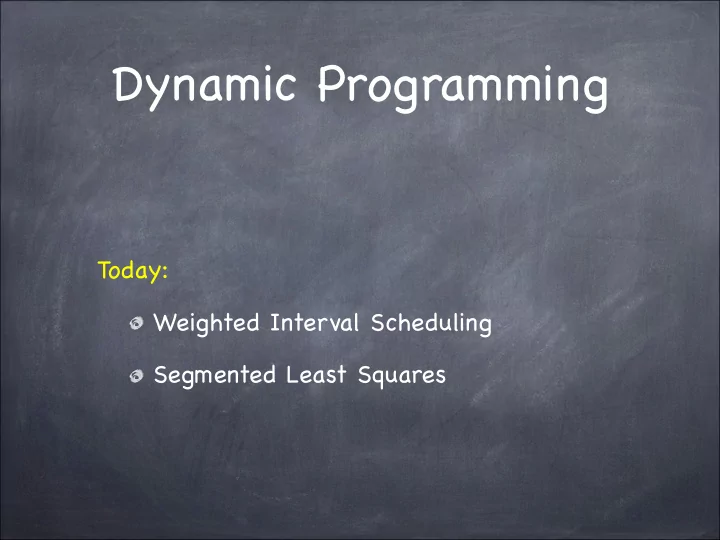

Dynamic Programming Today: Weighted Interval Scheduling Segmented Least Squares
Weighted Interval Scheduling
Recursive Algorithm Compute-Opt(j) { if j == 0 then return 0 else return max(v j + Compute-Opt(p(j)), Compute-Opt(j-1)) end } Running time?
Worst Case Running Time 5 4 3 1 2 3 2 2 1 3 4 2 1 1 0 1 0 5 1 0 p(1) = 0, p(j) = j-2 Worst-case running time is exponential.
Memoization Store results of each sub-problem in an array. Initialize M[j] to be “empty” for j=1,…,n M-Compute-Opt(j) { if j == 0 then return 0 else if M[j] is empty then M[j] = max(w j + M-Compute-Opt(p(j)), M-Compute-Opt(j-1)) end if return M[j] } This gives O(n) running time! ...but we’ll see an even easier approach
Iterative Solution Solve subproblems in ascending order Iterative-Compute-Opt { M[0] = 0 for j = 1 to n M[j] = max(v j + M[p(j)], M[j-1]) end } Running time is obviously O(n)
Finding the Solution (Not just value) Exercise: suppose you are given the array M, so that M[j] = OPT(j). How can you produce the optimal set of jobs? Hint: first decide whether job n is part of optimal solution
Find-Solution Use the recurrence a second time to “backtrack” through M array Find-Solution(M, j) { if j == 0 return {} else if v j + M[p(j)] > M[j-1] then return {j} ∪ Find-Solution(M, p(j)) / / case 1 else return Find-Solution(M, j-1) / / case 2 end } Call Find-Solution(M, n)
Dynamic Programming “Recipe” Recursive formulation of optimal solution in terms of subproblems Only polynomially many different subproblems Iterate through subproblems in order Interval scheduling: n subproblems
Segmented Least Squares
A Second Example of Dynamic Programming Two important questions: (1) how many subproblems? and (2) what does recurrence look like? (how many cases?) Weighted Interval scheduling n subproblems Two cases: include j or don’ t include j Segmented Least Squares n subproblems Many cases...
Ordinary Least Squares (OLS) Foundational problem in statistics and numerical analysis. Given n points in the plane: (x 1 , y 1 ), (x 2 , y 2 ) , . . . , (x n , y n ). Find a line y = ax + b that minimizes the sum of the squared error: y n x SSE = ( y i − ax i − b ) 2 ∑ i = 1
Least Squares Solution Result from calculus, least squares achieved when: ∑ y i − a ∑ x i y i − ( ∑ ∑ ∑ x i n x i ) y i ) ( i i i i i a = b = , 2 − ( n ∑ ∑ x i ) 2 n x i i i We will use this as a subroutine (running time O(n))
Least Squares Sometimes a single line does not work very well. y x
Segmented Least Squares Given n points in the plane (x 1 , y 1 ), (x 2 , y 2 ) , . . . , (x n , y n ) with x 1 < x 2 < ... < x n , find a sequence of lines that fits well. y x No longer have a simple solution from calculus
Segmented Least Squares Issue: how many lines? With too many lines, you can get a prefect solution, but there may be a much simpler explanation (e.g., two lines) y x
Segmented Least Squares Idea: Find a sequence to minimize some combination of: the total error from each segment the number of lines y x
Segmented Least Squares Finish problem formulation and develop recurrence on board
Segmented Least Squares: Algorithm Cost Segmented-Least-Squares() { for all pairs i < j compute the least square error e ij for O(n 3 ) the segment p i ,…, p j end M[0] = 0 for j = 1 to n O(n 2 ) M[j] = min 1 ≤ i ≤ j (e ij + C + M[i-1]) end Total = O(n 3 ) return M[n] }
Segmented Least Squares: A Second Example Weighted Interval scheduling n subproblems Two cases: include j or don’ t include j Segmented Least Squares n subproblems Up to n cases (select starting point p i of final segment, i ≤ j)
Recommend
More recommend